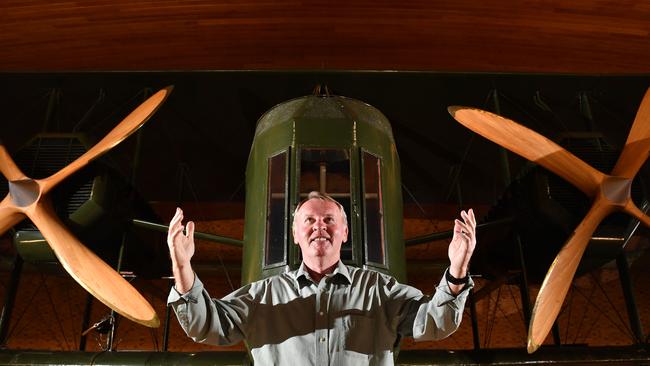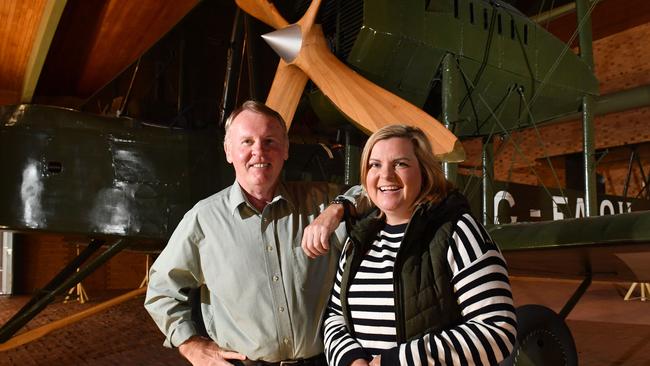South Australian astronaut Andy Thomas and iconic aircraft Vickers Vimy joined in history
When SA astronaut Andy Thomas was blasted into orbit on board the Space Shuttle Endeavour in 1996 he carried a collection of Australian artefacts with him — including the pilot wings of two South Australians who rewrote what people thought was possible. So what is next for the iconic Vickers Vimy aircraft?

SA News
Don't miss out on the headlines from SA News. Followed categories will be added to My News.
- One of aviation’s most famous aircraft has been ignored in Adelaide
- Entrepreneur Dick Smith furious over Vickers Vimy bomber
- Podcast: The incredible true story of South Australian brothers
When South Australian astronaut Andy Thomas was blasted into orbit on board the Space Shuttle Endeavour in 1996 he carried a collection of Australian artefacts with him.
There was a black opal ring that was part of his family history, there was a piece of wood from the anchor of Captain James Cook’s original Endeavour, and there were the pilot wings once worn by two South Australian brothers when they changed what people thought was possible in an aeroplane.
Ross and Keith Smith, and their mechanics Jim Bennett and Wally Shiers flew their Vickers Vimy from Great Britain to Australia in 29 days, collecting a 10,000 pound prize and opening up what would become an important air route.
The Smith brothers, who could have collected the prize just for landing in Darwin but decided to continue on to Adelaide anyway, came home to a heroes welcome.
The war-weary public were eager for good news, and this was great news indeed.
But despite the initial excitement, they never really claimed their rightful place in aviation history.
Technology was moving so fast that in just a few years the feat seemed unremarkable. Ross’s death just two years after the race seemed to be the full stop on the story.
The huge Vickers is now parked in a hangar adjacent Adelaide Airport’s long-term carpark, its main visitors made up of people taking a curious glance as they hurry back to their cars after holidays and business trips.
For Dr Thomas, however, the aircraft stands as a memorial to just what can be achieved by brave people with a will to succeed.
The kind of people who lit a fire under him as a child and inspired him to become an astronaut.
“You have to ask yourself how did they succeed when others did not, and part of the answer is here,” Dr Thomas said, looking up at the aircraft’s huge engines.
“This aeroplane was powered by two Rolls Royce Eagle engines. These engines were state of the art in 1919 and the only source of the high-reliability engines that were needed for this type of mission.”
It’s immediately obvious that, when it comes to the Smith brothers’ Vickers Vimy, Dr Thomas knows his stuff.
“It was a name that I was very familiar with,” he said.
“When people ask why I’m here in Adelaide I tell them we’re making a documentary on the Smith brothers and the Vimy and many people look at me like, ‘Who? It’s surprising that this is an unknown story.”

The documentary is The Greatest Air Race And The Heroes The World Forgot, currently in production for release next year as part of the Epic Flight Centenary celebrations to mark the 100 year anniversary of the race.
Dr Thomas has signed on as the doco’s presenter and narrator.
“Think about this — just 50 years after this race Neil and Buzz walked on the moon,” he said. “That means my maternal grandfather, who had been wounded at Gallipoli, was in Adelaide when the Smith brothers landed and he was alive when they walked on the moon.”
It was this rapid pace of development, Dr Thomas said, that contributed to the brothers being largely forgotten.
“There were many other aviation feats that eclipsed it, not the least of which was Charles Kingsford Smith,” he said.
“And the fact that the Smith name got tied together in people’s minds didn’t help either. Charles Lindbergh, Amelia Earhart — they all eclipsed it in people’s minds because they were individual feats and that resonated more with the public.
“It was the lone battle against the elements, an almost Arthurian legend and it generated a lot of public interest. Of course Ross Smith died in the early twenties, and he was clearly the driver behind a lot of this activity. He planned the flight and executed a lot of it and his early death led to a lot of the history being forgotten about prematurely.
Walking around the plane, Dr Thomas pointed to a flimsy wire barrier on the side of the aircraft’s open cockpit.
“You see that wire mesh?” he said.
“That’s there so that they didn’t inadvertently put their hand out the side and get clipped by the propeller. The propeller was right there. Just imagine the thundering noise!”

It’s a tangible reminder of just how low-fi these early aviation missions were — flying by site with only paper maps to guide them, open cockpits, bench seats, landing on makeshift landing strips.
“It’s interesting to contemplate — what would Ross and Keith Smith made of the idea of their wings being launched into space and orbiting the earth 16 times a day and completing the distance they completed in 28 days in 20 or so minutes?” Dr Thomas said.
The Adelaide-born astronaut has backed calls for the Vickers Vimy to be housed in a more prominent position, calls that the airport management has heard.
“It should have a better home,” he said.
“This should be located in the new airport. Given enough space this could be a magnificent display. It’s one of the biggest pieces of aviation relics in human history.
“The Spirit of St Louis is tiny compared to this. This is a big aeroplane.”
Adelaide Airport executive general manager of finance and corporate, Brenton Cox, said the airport “recognises that the Vickers Vimy is a treasured national asset”.
“However, the aircraft is also very fragile and the logistics of relocating it are extremely complex.
“Moving her would be a high risk and expensive venture, so if we do choose to relocate the Vimy, it needs to be her home for a very long time.”
Mr Cox said early discussions with both the State and Federal Governments had been held to discuss funding the move.
“The terminal expansion project we announced in June includes flexibility in the design to allow for this relocation.
“We’re looking forward to celebrating next year’s centenary, and all going well we hope we’ll have some good news on the future of the Vimy.”
To find out more about the Epic Flight Centenary celebrations, and to sign up to the newsletter, go to history.sa.gov.au/events/centenary-of-epic-flight/


